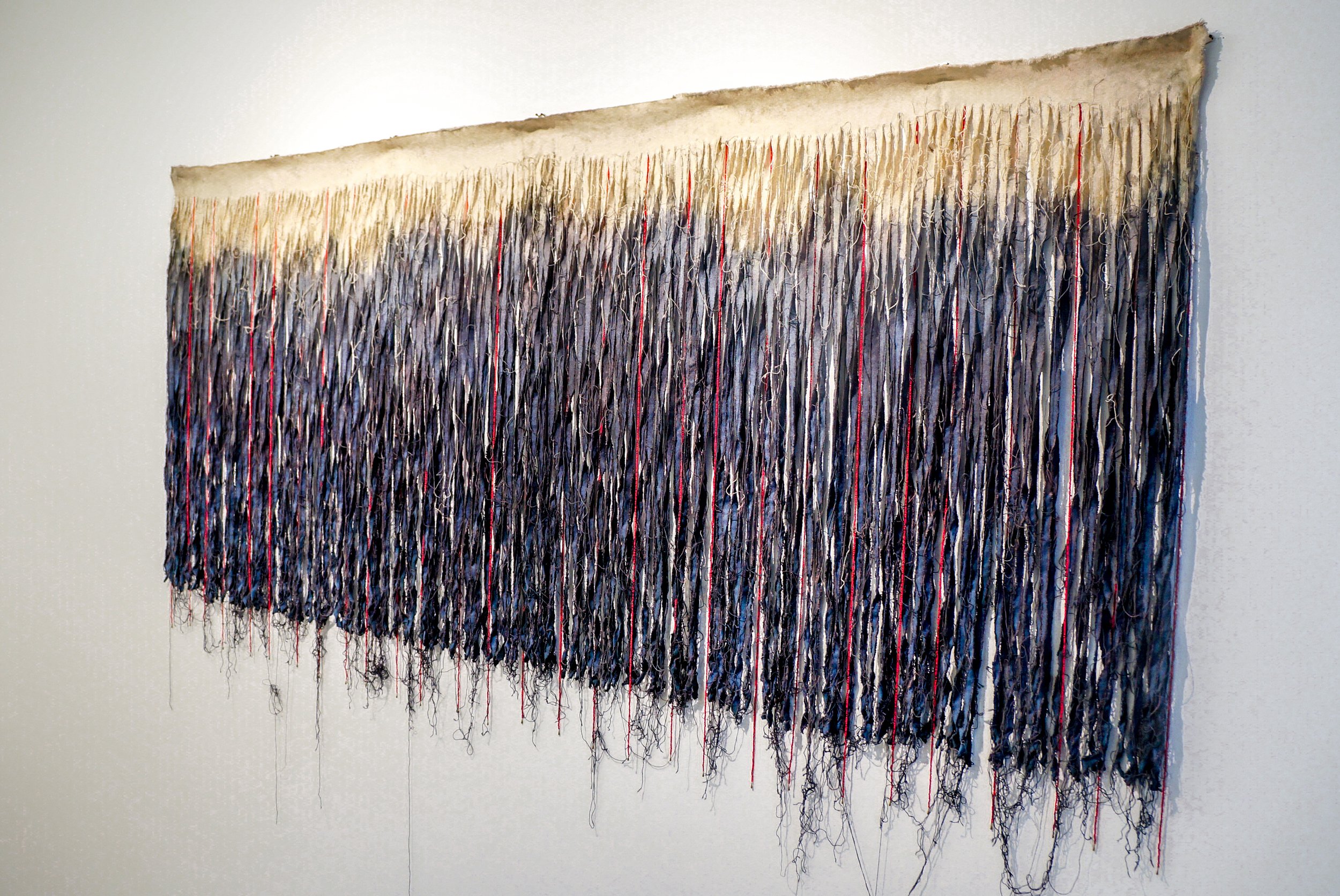REVIEW: Building On Heritages and Reclaiming Indigeneity: “Native Futures” at the Center for Native Futures
Image: Chelsea Baghorn, Lakota, Dakota, Shoshone-Paiute, and European; Untitled (Black Fringe), 2023, canvas, MX dye, beads, 7’ x 3’. Photo by Xiao deCunha, courtesy the Center for Native Futures.
REVIEW
The Center for Native Futures, “Native Futures”
56 W. Adams St., Suite 102
Chicago IL 60603
Sept. 16 2023 - May 17, 2024
By Xiao deCunha
“Museums can be very painful sites for Native peoples, as they are intimately tied to the colonization process,” Amy Lonetree, a Ho-Chunk Nation art historian, wrote in the Introduction of Decolonizing Museums: Representing Native America in National and Tribal Museums [1]. For decades, the public has shaped their understanding of the Native people and their culture around museum and curator-led collections and exhibitions that are often outdated and unrepresentative, erasing not only the indigenous community’s history and heritage but also the progression and development.
As such, indigenous people must reclaim their collective identity.
Chicago’s first and only native-artist-operated fine arts organization, Center of Native Futures (CfNF), presented its inaugural eponymous exhibition, Native Futures, last September. The exhibition is on view through May 17. Over a dozen Native artists from the Great Lakes region at different career stages participated in the exhibition, including CfNF co-founders, Noelle Garcia, Kelly Church, Jason Wesaw, Tom Jones, Holly Wilson, John Hitchcock, Camille Billie, June Carpenter, Codak Smith, Le’Ana Asher, Dakota Mace, Ji Hae Yepa-Pappan, Chelsea Big Horn, Lydia Cheshewalla, Hattie Lee, and TIES poets.
To understand Native Futures, we must remind ourselves that we can only fathom a future based on our experiences. When we live in a world that lacks compassion, we long for a compassionate future. When we struggle with visibility and validation, we yearn for a future where we are seen and heard. Hence, many pieces in the exhibition look back to the creator’s private memories and inherited cultural heritage.
Image: Native Futures, installation view. Photo by Xiao deCunha, courtesy the Center for Native Futures (CfNF).
For example, Hattie Lee Mendoza (Cherokee tribe) returns to her childhood memories of her mother and grandmother’s encyclopedia sets. For Mendoza, the astonishingly high value of a new set of encyclopedias, the joyful memories they carry for her family serving as means to learn about the world, and the scarcity of entries on Native American tribes turned the books into irreplaceable ephemerals in her life. Therefore, when she found a partial set in Encyclopedia Britannica, she collaged her tribal heritage, her family’s nostalgia, and her personal values and living experience into the pages — and Cherokee Britannica was born.
The work on display features 14 pieces, each featuring colorful designs mimicking traditional basketry patterns. The abstract shapes are blended into the encyclopedia pages using leftover paint chips from the artist’s past office, pages from other discarded books, and colored pencils. The creation process behind Cherokee Britannica manifests how younger generations contribute to the collective Native future by inheriting the culture and tradition passed through their bloodline while adding their unique narratives to reshape old stories.
Image: Native Futures, installation view. Photo by Xiao deCunha, courtesy the Center for Native Futures (CfNF).
Other pieces in the exhibition addressed the methodological and philosophical aspects of creating Native futures. The keywords these artworks jointly emphasize are kindness, self-appreciation, compassion, and positivity.
In Spectrums Within Under Our Skin, Holly Wilson (Delaware Nation) created 144 girls in a 12x12 matrix using Crayola Crayon. Wilson used the 12 colors in the spectrum of a ray of light to remind the viewer to see the light within themselves and appreciate their ability to create such warmth. “We are more than classifications regarding a position between two extremes; we are all the colors and an untold number of possibilities,” Wilson wrote in the description. “ It takes all these colors to create the light.”
Artists also addressed the severe erasure and dishonest retelling of Native history in mainstream institutions.
Image: Native Futures, installation view. Photo by Xiao deCunha, courtesy the Center for Native Futures (CfNF).
In The Sun Through the Darkness, June Carpenter (Osage/Shawnee) retold the Roman myth of Proserpina and Pluto. Pluto, lord of the Underworld, kidnapped Proserpina to be his queen. Enraged and heartbroken, Ceres, Proserpina’s mother, searched for her daughter across the land, spreading blights everywhere she went. In the myth, Jupiter, God of all Gods, reached a semi-pacifist compromise, allowing Proserpina to split her time between her mother and her self-proclaimed husband. In Carpenter’s adaptation, the rightfully furious mother was mercilessly struck down for seeking and defending her daughter. Left alone and grieving, Proserpina mustered up her courage and returned to the living world.
The original myth shares a heartbreaking similarity to the actual history of the Native people. Those who stood up against the settler authority met their demises more often than ever, earning a chance to negotiate. Families were torn instead of reunited. The happy ending always came with unspeakable hardship and endurance instead of a handout from a mightier power.
Carpenter ended things on a hopeful note: the Native people will stand under sunlight freely and safely. Their past and memory will be honored and respected, and their stories and heritage will be told properly and truthfully. On view through May 17, Native Futures is the first step towards that goal. The exhibition is a reclamation of indigeneity, standing firmly against the biased and modified narrative traditional institutions have developed around the Native identity. From this point, the Native people will build their own narrative.
[1] Amy Lonetree, “Introduction: Native Americans and Museums,” introduction, in Decolonizing Museums: Representing Native America in National and Tribal Museums (Chapel Hill, NC: The University of North Carolina Press, 2012), 1–28
Xiao daCunha is a writer and artist living in Chicago and Kansas City, Missouri.
Like what you’re reading? Consider donating a few dollars to our writer’s fund and help us keep publishing every Monday.






